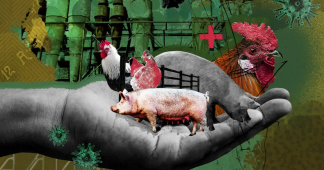Since last summer, the conservative campaign against vaccination has claimed thousands of lives for no ethically justifiable purpose.
By Kurt Andersen
About the author: Kurt Andersen is the author of Evil Geniuses: The Unmaking of America: A Recent History.
In the early phases of the pandemic, as the coronavirus spread in the United States and doctors and pharmacists and supermarket clerks continued to work and risk infection, some commentators made reference—metaphorical reference, fast and loose and over the top—to ritual human sacrifice. The immediate panicky focus on resuming business as usual in order to keep the stock market from crashing was the equivalent of “those who offered human sacrifices to Moloch,” according to the writer Kitanya Harrison. That first summer, as Republicans settled into their anti-testing, anti-lockdown, anti-mask, nothing-to-worry-about orthodoxy, Representative Jamie Raskin, a Democrat, said it was “like a policy of mass human sacrifice.” The anthropology professor Shan-Estelle Brown and the researcher Zoe Pearson wrote that people who continued to do their jobs outside their homes were essentially victims of “involuntary human sacrifice, made to look voluntary.” Meanwhile, people on the right likewise compared the inconvenience of closing down public places to ritual sacrifice.
I got in on the analogy too: After Donald Trump’s first big indoor pandemic campaign rally in June 2020, I made a crack on Twitter that for the 6,000 MAGA folks attending it was like a “human sacrifice to please the leader.” And indeed at least once during the month before the rally, Trump played the part of a gung-ho godlike king presiding over the glorious sacrificial deaths of his subjects. When asked, during an Oval Office encounter with the press, whether the nation will “just have to accept the idea that … there will be more deaths” as a result of his open-everything-up-now plan, he said, “I call these people warriors, and I’m actually calling now … the nation, warriors. We have to be warriors.”
“Warriors,” “mass human sacrifice”: These were high-pitched figures of speech studding a debate about our political economy—whether and how governments should intervene to keep people and businesses financially afloat, and how many lives were worth how much of a hit to the economy. Beneath the polemics this discourse was at least fundamentally rational, a weighing of social costs against social benefits.
Today, however, the economy is no longer in jeopardy; unemployment rates and salaries have returned to pre-pandemic levels; GDP per person is higher than it was at the end of 2019; personal savings are growing, and businesses are starting up faster than ever; corporate profits and stock prices are at record highs. And for more than a year, we’ve had astoundingly effective vaccines that radically reduce the risk of hospitalization and death from COVID-19. All of which means that for a long time now the right’s ongoing propaganda campaign against and organized political resistance to vaccination, among other public-health protocols, has been killing many, many Americans for no reasonable, ethically justifiable social purpose.
In other words, what we’ve experienced certainly since the middle of 2021 is literally ritual human sacrifice on a mass scale—the real thing, comparable to the innumerable ghastly historical versions.
Anthropologists define ritual sacrifice as societies’ organized killing of people in order to please supernatural beings and—the unspoken real-world part—to fortify the political and economic power of those societies’ elites. The tradition is right there in the first book of the Bible, when God commands Abraham to prove he loves him by murdering his son, and then only at the last second lets Abraham off the hook. For thousands of years in societies all over the world, small-scale and large-scale human sacrifice was common.
One big difference between then and now is the likelihood of death. In sacrificial spectacles hundreds and thousands of years ago, almost all of those chosen to die died, whether or not they had volunteered, whereas only a fraction of the people now volunteering to die by forgoing vaccinations actually do. It’s the new and improved modern version of mass human sacrifice.
But as I surveyed the anthropological literature, I was struck again and again by how well that scholarship describes the factors responsible for the thousands of deaths of Americans each month. Our current experience with COVID is filled with what historians of human sacrifice have identified as its key features. Let me run through the main ones.
1. Cultural and social complexity
The literature suggests that, far from happening only in simple societies, “human sacrifice stamps relatively advanced and especially decadent peoples,” as the Cambridge University scholar Stanley Arthur Cook concluded a century ago, just as the practice finally seemed to be disappearing. In the introduction to The Strange World of Human Sacrifice (2007), the religious historian Jan Bremmer wrote, “Human sacrifice is not something that is typical of marginal or minor tribes. On the contrary, as a regular practice on a grander scale, human sacrifice seems to belong to … larger empires”—“more developed cultures” that “have a strong government” and thus “could happily dispose” of people “without the community suffering a disastrous loss of members.” A groundbreaking 2016 study of scores of socially complex cultures across the Pacific and East Asia found that “sacrificial victims were typically of low status.” In various places around the world, the victims of human sacrifice tended to be elderly, ill, or both.
Today in the U.S.—the world’s most powerful empire and third-most-populous nation, possessor of a strong government and social and political complexity, a culture both advanced and decadent—two-thirds of COVID victims have had incomes below the median. Three-quarters have been 65 or older, with a median age of over 75.
2. Intense social stress
“The sacrifices,” Bremmer wrote, “often took place during exceptional circumstances … in periods of crisis.” In Inca societies in 15th- and 16th-century South America, according to a 2015 paper, “sacrifices were often conducted in response to natural calamities, such as … epidemics,” “based on their belief that illness and natural disasters were forms of supernatural punishment for sins committed.”
Accompanying the exceptional health crisis of COVID-19 were the immediate economic and social crises: public life shut down, a spike in violent crime, a one-third drop in stock prices, an economic recession, unemployment near 15 percent. In the spring of 2020, a University of Chicago survey found that of the 80 percent of Americans who believe in God, more than 60 percent at least somewhat agreed that the pandemic was “God telling humanity to change how we are living”; 43 percent of evangelicals “strongly” felt that to be true. In a different 2020 survey, three in five white evangelicals agreed that the pandemic and its ramifications were “evidence that we are living in what the Bible calls the ‘end times.’”
Naturally, many Christian ultra-conservatives rushed to put a finer point on it, including reliable superstars such as Pat Robertson, who declared, “We’ve allowed this terrible plague to spread throughout our society—and it’s a small wonder God would hold us guilty.” Notably, most believers apparently didn’t judge themselves to be sinners deserving of this punishment: According to the University of Chicago survey at the start of the pandemic, 55 percent thought God would protect them from infection.
3. Politics plus faith
According to the literature, human sacrifice occurred in societies where highly supernatural religion and state governance were deeply intertwined.
For some time in the U.S., evangelicals have made up about a third of Republicans, and 78 percent of all U.S. evangelical voters chose the GOP nominee in 2020. Donald Trump is a conspicuously un-Christian leader for an ultra-Christian party, but he is a showman, like the most successful evangelists throughout American history. In the fall of 2020, he put on a spectacular pandemic show with a Christian subtext: Infected with the coronavirus, he entered the valley of the shadow of death on a Friday. Three days later, he returned, on live TV, descending from the sky before surmounting America’s great secular temple and ceremoniously removing his mask, resurrected.
Even his most fervidly Christian supporters have never minded that he shares practically none of their theological beliefs. Indeed, his leadership of the American right is apparently making evangelical and Republican more or less synonymous in the minds of Trumpists. A longitudinal study by Pew of 2,900 Americans identified a peculiar sliver of the white people who liked Trump when he first ran for president: In 2016, a sixth of those white Americans didn’t identify as evangelicals or born again, but by 2020 they did. Republicanism has been transformed by the merger of religion and partisanship that started before the turn of this century. “If more and more of a political party’s members hold more and more extravagantly supernatural beliefs,” I wrote about the 21st-century GOP’s anti-modern denial of various empirical realities in my 2017 book, Fantasyland, “doesn’t it make sense that the party will be more and more open to make-believe in its politics and policy?”
4. Enormous scale
The human sacrifices carried out in the 15th and 16th centuries by the Aztecs, “a relatively young empire,” killed thousands of people and perhaps tens of thousands annually. For that civilization, according to Science’s Mexico-based archaeology and Latin American correspondent, “political power as well as religious belief is likely key to understanding the scale of the practice.”
Relatively young North American empire? Check. An annual count of victims in the thousands? Check. Driven by religious belief and politically powerful figures seeking to sustain their power? Check.
5. Victims volunteer and “volunteer”
In the Quranic version of the story, when Abraham is ordered by the Almighty to murder his son, the boy voluntarily submits to the plan in order to please God. The Aztecs’ “sacrificial victims earned a special, honored place in the afterlife,” according to one account; another declared that many “went willingly to the sacrificial altar.” The historian Bremmer writes that in the ritual sacrifices carried out by India’s Kond people into the 1800s, “the victims were always treated with great kindness before being sacrificed” to “the founding goddess of the village” and that, “in turn, the Konds expected them to offer themselves voluntarily.” Not surprisingly, when it comes to human sacrifice, the lines between voluntary and involuntary, suicide and murder, can be blurry. In the blood sacrifices practiced by the indigenous Chukchi people of Siberia well into the 19th century, the anthropologist Rane Willerslev explained in a 2013 paper, their ritual of so-called voluntary death was accomplished by means of various forms of “sacrificial trickery.”
Millions of Americans in 2021 were tricked by propagandists of the political right into forgoing vaccination and thus volunteering for death by COVID. Fox News hosts have consistently disparaged vaccination. During 2021, according to Media Matters, Tucker Carlson discussed vaccines on half of his nightly broadcasts after Joe Biden became president, “and all but one of those episodes featured a claim that undermined vaccines or vaccination efforts.” One night this month he said, “The boosters aren’t working” and “there’s evidence that people who get the booster are more likely” to become infected. The median age of Fox News viewers is 65. Unvaccinated people from 65 to 79 are now 21 times as likely to die of COVID as vaccinated people the same age, and unvaccinated Americans 50 and older are 44 times likelier to be hospitalized than the vaccinated and boosted.
Last fall, Joy Pullmann, the executive editor of the well-funded right-wing magazine The Federalist, published a remarkable essay there headlined “For Christians, Dying From COVID (Or Anything Else) Is a Good Thing.” She portrays vaccination, along with other pandemic mitigation, as part of an “illusion of human control over death,” because, she insists, “there is nothing we can do to make our days on earth one second longer.” And, according to her, “the Christian faith makes it very clear that death, while sad to those left behind and a tragic consequence of human sin, is now good for all who believe in Christ.”
Indeed, Pullmann continues, “it is time for Christians individually and corporately to repent for the way we and our institutions responded to the COVID-19 outbreak”—that is, apparently, to seek forgiveness for their sins of quarantining, getting vaccinated, actively avoiding death. Christians, she writes at one point, are “routinely martyred” in Communist China and “raped and ethnically cleansed to punish their beliefs” in the Middle East. She declares, “It’s time for we comparatively comfortable Westerners to despise the shame”—the shame of trying to avoid death by COVID—“and get back to running our race like [our] fellow Christians, not cowards.”
This argument reminds me of the Disciples of Christ minister who famously encouraged his hundreds of devout, credulous followers to die nobly at their Peoples Temple compound in 1978. “Be kind to seniors and take the potion,” Jim Jones told the residents of Jonestown gathered near the vats of poisoned Flavor Aid, with his armed lieutenants ensuring compliance. “Die with a degree of dignity,” he declares on a recording of that event, above the screams of some of his followers. “Lay down your life with dignity. Don’t lay down with tears and agony. Stop the hysterics.”
But today, instead of frankly rousing true believers to volunteer to die for Christ (or, as Trump demanded in 2020, for the economy), most orchestrators of the current mass-sacrifice campaign employ fear-based trickery. In Vero Beach, Florida, the right-wing pastor Rick Wiles (his surname a synonym for manipulative tricks!) has said that demons are “implementing a plan that they created 10-15 years ago” and insisted that the vaccines are “Satan’s syrup.” In Boynton Beach, Florida, one of the state’s three Republican National Committee members (whose day job is probate law, distributing the property of the dead) wrote that “Diabolical [Democratic] Michigan Governor Whiter [sic] wants her citizens to get the Mark of the Beast to participate in society.” Trump’s crypto-Republican buddy Kanye West announced back in July 2020 that “vaccines are the mark of the beast. They want to put chips inside of us, they want to do all kinds of things, to make it where we can’t cross the gates of heaven.”
And the right’s QAnon anti-vaccination cohort has produced its own eager volunteers for mass human sacrifice—volunteers probably oblivious to the irony that their own conspiracy theories center on a fantasy that elite liberals practice gruesome human sacrifice.
The original Protestants 500 years ago, and in particular the extreme ones who self-exiled to the New World 400 years ago, very much identified as a fervent Christian minority persecuted by powerful ungodly elites. The fundamentalist Protestant revival that got under way in the U.S. a century ago was specifically anti-science, because adherents’ literal reading of Genesis didn’t jibe with modern geology or astronomy or biology. Starting in the 1960s and ’70s, their next U.S. revival resumed that crusade and extended it to other scientific realms, lately including virology. Not only are white Protestant evangelicals less likely than any other large American religious demographic to be vaccinated, but, according to the Public Religion Research Institute, those “who attend religious services regularly are twice as likely as less frequent attenders to be vaccine refusers.”
6. Participants’ murky understandings
Overseers and victims of human sacrifice don’t necessarily understand its goals, ostensible or real. “Many times when witnessing sacrifices,” the Russian ethnologist Vladimir Bogoraz wrote in his classic early-1900s monograph on the Siberian Chukchi, “… I asked to whom the sacrifice was being proffered. The answer was, ‘Who knows!’” The Chukchi expert Willerslev says this shows the witnesses’ lack of “any strenuous commitment to faith,” that the “rite of sacrifice is somehow thought to be effective as long as the ritual rules are followed”—that is, even the awareness of trickery doesn’t necessarily dissuade participants.
Bureaucratic trickery has been a consistent part of Republican-led governments’ COVID policies. The 2021 year-end staff report by the House Select Subcommittee on the Coronavirus Crisis lays out how the Trump administration worked to keep citizens uninformed about the risks of the virus and about the scale of the mass death that was about to occur. In the spring of 2020, when the White House ordered the CDC to loosen its recommendations to churches about masking and social distancing, the CDC’s “incident manager,” Jay Butler, emailed a colleague to say that “this is not good public health—I am very troubled on this Sunday morning that there will be people who will get sick and perhaps die because of what we were forced to do.” Butler also had misgivings “as someone who has been speaking to churches and pastors on this (and as someone who goes to church).” Trump and his administration discouraged testing for infection from the start. As Deborah Birx, the former White House pandemic coordinator, told the House subcommittee this past fall, the “less aggressive testing of those without symptoms” was “the primary reason for the early community spread.”
A long-standing theory of human sacrifice, the “social-control hypothesis,” has argued that social elites used it to keep the hoi polloi subservient. But the evidence was scattered and anecdotal, untested by the most rigorous modern scholarship. One big question: What distinguished the cultures that practiced human sacrifice from those that did not? Thanks to a massive historical database of the social and genetic particulars of a hundred traditional societies spread over a sixth of the planet, from the eastern Pacific to Australia and East Asia, in 2016 we got one definitive answer: “Ritual human sacrifice,” an official summary of the research said, “played a central role in helping those at the top of the social hierarchy maintain power over those at the bottom.”
Researchers from the University of Auckland, Australia’s Victoria University, and the Max Planck Institute for the Science of Human History categorized 93 Austronesian societies, 40 of which practiced human sacrifice, according to three levels of socioeconomic fairness—from most egalitarian, where children didn’t inherit wealth or status from parents, to totally nonegalitarian, where children could acquire wealth and status only by inheritance. The results are stark: The less fair a society’s socioeconomic system was, the more likely it was to practice human sacrifice—67 percent of the least egalitarian societies versus only 25 percent of the most egalitarian and 37 percent of those in the middle. More specifically, the researchers wrote, “human sacrifice substantially increased the chances of high social stratification arising,” “increased the rate at which” those societies “gain high social stratification,” and “stabilizes social stratification once stratification has arisen.”
Do I even need to make the point that in America since the 1970s, as a result of the reengineering of our political economy led by Republicans, Big Business, and the rich, the U.S. has become much less egalitarian, inequality and stratification have radically increased, and socioeconomic mobility has radically decreased?
Whether they were convinced that COVID wasn’t real; that if it was, God would keep them alive or, alternatively, use COVID to kill them on schedule; that vaccines are “Satan’s syrup” or make you sterile or worse; that in any case vaccination mandates are, like gun regulation, a tyrannical plot by liberals and globalists; or that the Omicron variant was introduced to deflect public attention from Ghislaine Maxwell’s trial (and, by the way, omicron and delta combined are an anagram for media control)—whatever their reasons, millions of Americans have been persuaded by the right to promote death, and potentially to sacrifice themselves and others, ostensibly for the sake of personal liberty but definitely as a means of increasing their tribal solidarity and inclination to vote Republican.
That’s why the Republican governor of Texas, after mandating masks early in the pandemic, gave in to his pro-sacrifice hard-liners last fall and issued a prohibition on businesses requiring customers to be vaccinated. It’s why at a November forum for the Republicans running for the U.S. Senate in Ohio, one candidate bragged that he was “the only one up here … who’s not vaxxed.” It’s why the Republican attorney general of Missouri, running for the U.S. Senate there, informed the state’s local health and school officials in December that any “mask mandates, quarantine orders, and other public health orders” concerning COVID are unconstitutional and thus “null and void,” which at least one county took to mean that it must end “all COVID-19 related work” of any kind. It’s why all 13 states that have legally prohibited vaccination mandates have Republican-controlled legislatures, and why at least five Republican states are paying unemployment benefits to people who leave their jobs because they refuse to be vaccinated.
Back in 2020, the Republican-led resistance to mask wearing and other public-health measures may have made people die unnecessarily, but if so it wasn’t killing that many more Republicans (or those in their vicinity) than other Americans. During the second half of 2021, however, after vaccines were available to all adults, that changed dramatically. Of the 20 least-vaccinated states today, Trump carried 17 in the 2020 election. According to one analysis, in the most Republican tenth of America only 42 percent of people were fully vaccinated by the end of last year. In Washington State, for example, the shrinking unvaccinated minority have lately comprised more than nine out of 10 COVID victims under 65, and three-quarters of the older ones. More and more, the unvaccinated (three out of five of whom are Republicans) and those killed by COVID are distinctly GOP subsets.
It was a graph I saw in the fall that startled me into taking the mass-human-sacrifice idea seriously. The Duke University sociologist Kieran Healy’s granular analysis plotted the number of deaths and degree of Republicanism in each of America’s 3,000 counties, then divided the counties into 10 groups from reddest to bluest, each containing a tenth of the U.S. population. In the reddest counties—those where 70 percent or more voted for Trump—the COVID death rates from last June through November were five or six times the death rates in places at the other end of the political scale. And step by step up the blue-to-red scale, the statistical correlation is amazingly consistent—the more Republican your county, the more likely you are to die of COVID.
At their imperial peak 500 years ago, the Aztec rulers sacrificed 20,000 or more people each year, some estimates suggest. By the reckoning of experts at the Kaiser Family Foundation, counting only the “COVID-19 deaths [that] could have been prevented by vaccination,” the number of Americans unnecessarily and avoidably killed in the U.S. from just last June to November is 163,000.
A week before Christmas, at a right-wing convention in Phoenix called Americafest, Sarah Palin said, “It’ll be over my dead body that I get a shot,” and “if enough of us rise up … there are more of us than there are of them.” (This week, as the federal trial of her defamation lawsuit against The New York Times was starting, she “tested positive for coronavirus,” the judge announced in court. “She is, of course, unvaccinated.”) In fact, 87 percent of adults have now been at least partially vaccinated. The 13 percent who have not are basically the same people who’ve said all along that they’d refuse to be vaccinated—and most of them, like Palin, are Republican, and nearly all the rest of them are Republican-leaning independents.
It’s notable that the Republican president who stirred up and led the anti-lockdown, anti-mask movement during 2020 never signed on to the anti-vaccine dogma. Despite gaining some natural immunity from having been infected, Trump was among the first to be vaccinated a year ago, then stepped right up to get a booster. Last summer, it seems like, he was persuaded by the overwhelming political logic of the numbers—by then a supermajority of the electorate was vaccinated, 70 percent and growing, while only about half of those remaining were still committed to the hard-core anti-vaccination vision. Trump obviously made a marketing choice to pivot away from those dead-enders.
“I believe totally in your freedoms, I do, you’ve got to do what you have to do,” he said at a rally in August on a farm in an Alabama county where 88 percent voted for him. But: “I recommend—take the vaccines, I did it, it’s good, take the vaccines.” Some people booed. Which made news, to which Trump is addicted. So in three interviews on three consecutive days at the end of the year, he went at it again, harder—with Bill O’Reilly on their joint speaking tour, on Fox News, and on The Daily Wire with the MAGA star Candace Owens.
For the past six years, few of his masses of fervent supporters—whether evangelical or irreligious—have objected much to any particular Trump heresy or inconsistency. Indeed, his extreme unpredictability is part of the show. And as he considers running for president in 2024, he must be acutely aware that his margins of victory and loss in 2016 and 2020 were mere thousands of votes in a few states, and that his voters are disproportionately the ones now being sacrificed. “I watched a couple of politicians be interviewed,” Trump said this month, “and one of the questions was, ‘Did you get the booster?’ … They’re answering like––in other words, the answer is ‘yes,’ but they don’t want to say it, because they’re gutless.” Perhaps his primary campaign has begun: His leading rival for the nomination, Florida Governor Ron DeSantis, keeps refusing to say whether he’s gotten a vaccine booster shot.
The pandemic will eventually finish its course, and the supply of sacrifice victims will run out. But the people who politicized and badly exacerbated this current mass-fatality event must now realize, if only unconsciously, that large-scale human sacrifice can be a useful modern political tool for a party ideologically committed to extreme inequality. What might be the next public-health crisis they can exploit? After all, for 40 years now they’ve proved their righteous power by sacrificing thousands of lives each year to the quasi-religious American fetish for guns.
But some emerging anthropology scholarship offers a glimmer of hope. Those 93 Austronesian societies in Asia and the Pacific where ritual sacrifice and inequality were strongly correlated all had populations of under a million. An ongoing cross-cultural study, based on a different, wider-ranging historical database called Seshat, has found an inverse correlation between human sacrifice and population: Organized, state-sanctioned sacrifice typically becomes unsustainable in larger societies. As Laura Spinney explained in The Atlantic in 2018, the Seshat data corpus “includes ‘mega-empires’ whose subjects numbered in the tens of millions,” and thus “tracks social complexity closer to modern levels.” Over time, the essentially parasitic nature of human sacrifice becomes more generally acknowledged. This “particularly pernicious form of inequality,” concludes the Oxford University anthropologist Harvey Whitehouse, one of Seshat’s founders, eventually disappears in very big societies “because they cannot survive with that level of injustice.”
So perhaps in a country of 330 million people, and even just within its super-red jurisdictions, the long-term governing prospects for the live-free-and-die GOP are inherently self-limiting. Maybe we have empirical grounds for hoping that the long arc of the moral universe will bend toward justice in this instance. For now, though, the death count keeps gratuitously rising.
Published at www.theatlantic.com
We remind our readers that publication of articles on our site does not mean that we agree with what is written. Our policy is to publish anything which we consider of interest, so as to assist our readers in forming their opinions. Sometimes we even publish articles with which we totally disagree, since we believe it is important for our readers to be informed on as wide a spectrum of views as possible.











